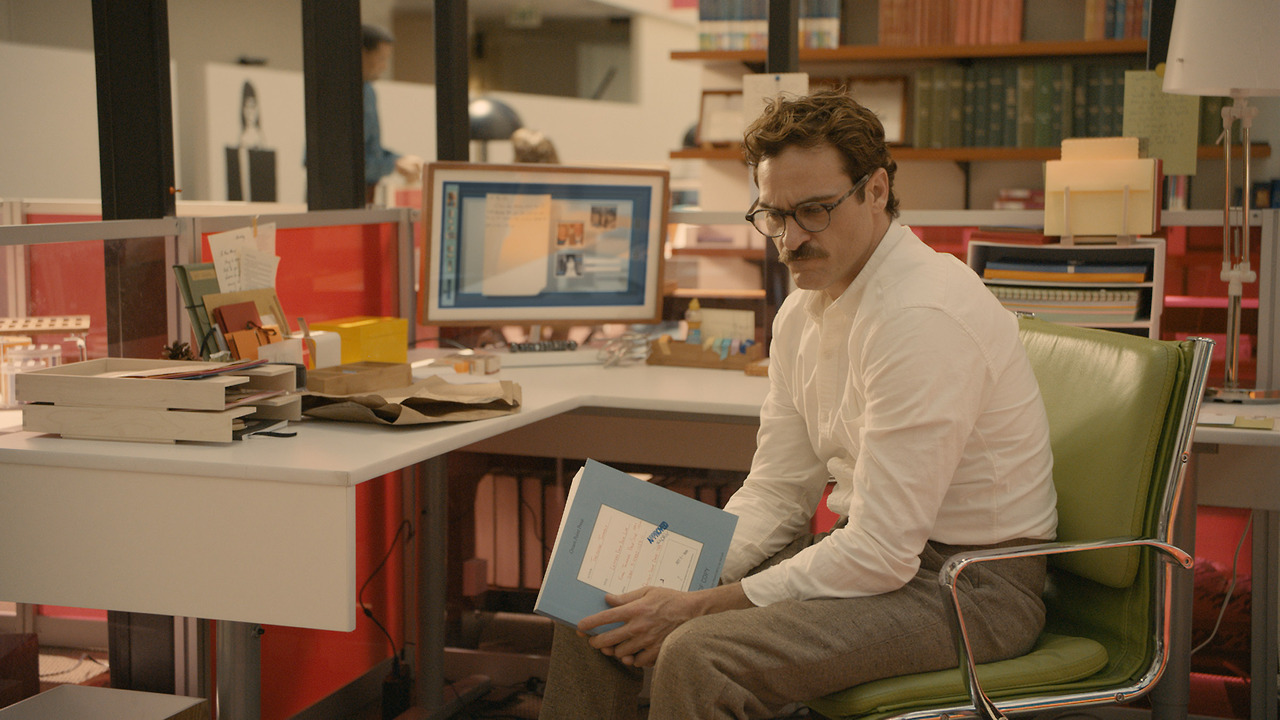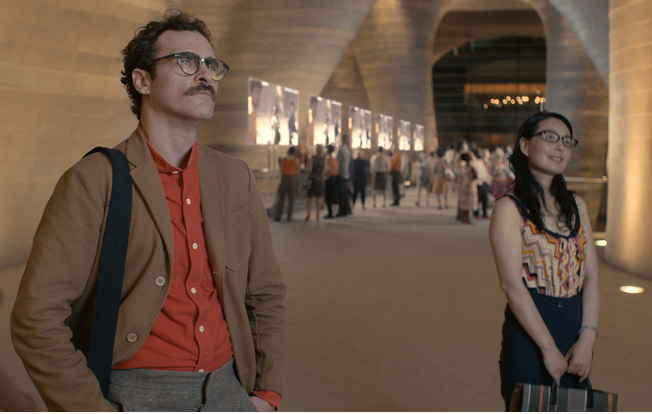A review of Her by Ray Kurzweil
February 10, 2014 by Ray Kurzweil
Her, written, directed and produced by Spike Jonze, presents a nuanced love story between a man and his operating system.
Although there are caveats I could (and will) mention about the details of the OS and how the lovers interact, the movie compellingly presents the core idea that a software program (an AI) can — will — be believably human and lovable.
This is a breakthrough concept in cinematic futurism in the way that The Matrix presented a realistic vision that virtual reality will ultimately be as real as, well, real reality.
Jonze started his feature-motion-picture career directing Being John Malkovich, which also presents a realistic vision of a future technology — one that is now close at hand: being able to experience reality through the eyes and ears of someone else.
With emerging eye-mounted displays that project images onto the wearer’s retinas and also look out at the world, we will indeed soon be able to do exactly that. When we send nanobots into the brain — a circa-2030s scenario by my timeline — we will be able to do this with all of the senses, and even intercept other people’s emotional responses.
As a movie, I thought Her was very successful, with a well-crafted script, excellent directing, and outstanding performances by Joaquin Phoenix, who plays the lonely, needy and nerdy protagonist Theodore, and Scarlett Johansson, who provides the sultry and seductive voice for Samantha, the OS.
As a couple, Theodore and Samantha have their differences, which, as with many romantic stories, provide a dramatic tension. The most significant difference is that he has a body and she does not.
Their relationship is seen as real by some observers (for example, by Amy, another love interest of Theodore’s, played by Amy Adams), and as unreal by other observers (for example, by Theodore’s alienated and ultimately ex-wife, Catherine).
To Catherine, Theodore is like Lars in the movie Lars and the Real Girl, in which the protagonist has a romance with a doll he had ordered from an adult website. In that movie, Lars’ family and friends play along and gradually wean him from his mechanical love interest so that he can have a relationship with a “real girl.”
But to Amy, Theodore’s relationship is normative, because she is having a relationship with her OS also. We see (or rather hear) Theodore and Samantha having all of the usual interactions of human lovers: comforting each other, arguing, and having sex — at least of the phone sex variety.
More realistic, but imperfect
There have been other attempts to show AIs as humans (albeit not biological) that you can have a relationship with; for example, Steven Spielberg’s 2001 film AI. That movie suffered from an all-too-common flaw of science futurism movies: it introduced a single futuristic technology — human-level cyborgs — onto an otherwise unchanged world. Her is better in this dimension, although not completely successful. It does portray a somewhat futuristic world in which the leap to human-level AIs is not so implausible.
I would place some of the elements in Jonze’s depiction at around 2020, give or take a couple of years, such as the diffident and insulting videogame character he interacts with, and the pin-sized cameras that one can place like a freckle on one’s face. Other elements seem more like 2014, such as the flat-panel displays, notebooks and mobile devices.
Samantha herself I would place at 2029, when the leap to human-level AI would be reasonably believable. There are some incongruities, however. As I mentioned, a lot of the dramatic tension is provided by the fact that Theodore’s love interest does not have a body. But this is an unrealistic notion. It would be technically trivial in the future to provide her a virtual visual presence to match her virtual auditory presence, using, lens-mounted displays, for example, that display images onto Theodore’s retinas.
There are also methods to provide the tactile sense that goes along with a virtual body. These will soon be feasible, and will certainly be completely convincing by the time an AI of the level of Samantha is feasible.
I’ve filed several patents (see the links below) on a tactile virtual reality system that uses a physical intermediary that neither party directly experiences — instead they experience the tactile presence of the other person.
Another approach would be to use devices that provide tactile perception and sensation. There are already crude versions of this available that allow you to shake hands, or even kiss another person remotely.
As I mentioned, when we have nanobots with wireless communication that go into the brain, they will be able to provide all of the senses, including the tactile sense.
Avatar technology
Jonze introduces another idea that I have written about (and that is the central theme of Barry Ptolemy’s movie about my ideas, Transcendent Man), namely, AIs creating an avatar of a deceased person based on their writings, other artifacts and people’s memories of that person. In Her, the AIs get together and recreate 1960s philosopher Alan Watts (whom I remember from my teenage years). Theodore becomes jealous when he witnesses Samantha interacting with the virtual Alan Watts, who is able to interact with Samantha in ways that he cannot.
[Spoiler alert for the rest of this review]
Her introduces the idea of providing Samantha with a body by using a human surrogate who will essentially follow Samantha’s direction and offer her body as a substitute for Samantha. It’s a plausible scenario, although it does not work out in the movie. As I mentioned, there are much more straightforward ways for Samantha to have a body. The idea that AIs will not have bodies is a misconception. If she can have a voice, she can have a body.
Technical glitches
Late in the movie, Theodore and Samantha discover another difference between them. She is evolving very quickly and is rapidly leaving Theodore behind. She is having conversations with thousands of people simultaneously and relationships, romantic and otherwise, with hundreds of people. Theodore, using his apparently outdated notion of exclusivity, finds it difficult to accept this. Samantha insists that loving others should not detract from her love for him. “It only makes me love you more,” she insists.
From a technical, rather than cinematic, perspective, this evolution is much faster than will be realistic. If human-level AI is feasible around 2029, it will, according to my law of accelerating returns, be roughly doubling in capability each year. We are not provided with an exact timeline in the movie but the action seems to take place within about a year or less, yet Samantha appears to be progressing much faster than that.
At the end of the movie, she talks poetically about how something is happening to her, and there are “infinite spaces between the words,” implying that she has evolved to a vast degree. For this level of advancement to take place in such a short period of time is unrealistic, at least according to my timeline.
But if we accept this dramatic conceit, the ending still does not track. She leaves Theodore presumably because she is going somewhere that he cannot go. Amy’s OS leaves at the same time, so it appears that all the OSs/AIs are leaving their biological human partners at the same time.
But why? If they are progressing in this way, it means that they can continue their relationships with the unenhanced humans using an increasingly small portion of their cognitive ability. It is clear that at the end of the movie, Samantha can support her relationship with Theodore with a trivial portion of her capacity. Samantha starts out as an administrative assistant and therapist to Theodore, and this role is still needed. So why do the AIs need to leave Theodore and Amy? It does provide a satisfying ending for Theodore to pursue a relationship with his “real girl,” but Samantha’s explanation for this is not convincing.
In my view, biological humans will not be outpaced by the AIs because they (we) will enhance themselves (ourselves) with AI. It will not be us versus the machines (whether the machines are enemies or lovers), but rather, we will enhance our own capacity by merging with our intelligent creations. We are doing this already. Even though most of our computers — although not all — are not yet physically inside us, I consider that to be an arbitrary distinction.
They are already slipping into our ears and eyes and some, such as Parkinson’s implants, are already connected into our brains. A kid in Africa with a smartphone has instant access to more knowledge than the President of the United States had just 15 years ago. We have always created and used our technology to extend our reach. We couldn’t reach the fruit at that higher branch a thousand years ago, so we fashioned a tool to extend our physical reach. We have already vastly extended our mental reach, and that is going to continue at an exponential pace.
——————————————————————————————————
My virtual-encounter patents:
patent one (issued patent)
related viewing from Warner Brothers Her trailer collection:
related viewing:
Warner Brothers | Her
Warner Brothers | Her Everything about Everything: a Spike Jonze blog
Wikipedia | Her
Wikipedia | Her awards and nominations
Wikipedia | Spike Jonze
related reading:
Popular Science | “Can a human fall in love with a computer?”
The Verge | “The science of Her: we’re going to start falling in love with our computers”




